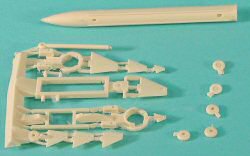
Anigrand Craftswork 1/72 X-7/X-8/X-9/X-17 X-Planes Missiles Set Kit First Look
By Michael Benolkin
| Date of Review | January 2007 | Manufacturer | Anigrand Craftswork |
|---|---|---|---|
| Subject | X-7/X-8/X-9/X-17 X-Planes Missiles Set | Scale | 1/72 |
| Kit Number | 2072 | Primary Media | Resin, White Metal |
| Pros | Beautiful casting, nice test-fit, even nicer detail | Cons | |
| Skill Level | Intermediate | MSRP (USD) | $64.00 |
First Look
 |
 |
 |
 |
 |
 |
With the successful penetration of the sound barrier in 1947 by Capt Charles 'Chuck' Yeager, the first of the X-plane series went into the history books. What would follow were a variety of special purpose research vehicles to broaden our understanding of subsonic, transonic, supersonic and hypersonic aerodynamics. Some of these experimental vehicles were so specialized that they were designed to be operated unmanned.
The Lockheed X-7 was a testbed for the use of ramjet engines, the knowledge of which was applied to programs like the Bomarc. The X-7 still holds the ultimate speed record for air-breathing aircraft of over 2,000 mph.
The Aerojet X-8 was a sounding rocket capable of Mach 6 and carrying a 150 pound research payload up to 200,000 feet. Remember that SpaceShipOne would carry a larger payload to 367,442 feet but at roughly half the speed (approx Mach 3).
The Bell X-9 was a testbed for Bell's GAM-63 Rascal air-to-surface guided missile. Ironically, the X-9 was more successful than the GAM-63 which was subsequently cancelled.
The Lockheed X-17 was the research vehicle used to understand the effects of high-speed re-entry on manned and unmanned spacecraft. The concept was simplicity itself. The three-stage rocket would boost only on its first stage to 500,000 feet. As the vehicle accelerated downhill through 120,000 feet and Mach 5 the second stage would kick the vehicle up to Mach 10. As the vehicle passed down through 72,000 feet, the third stage would push the vehicle through Mach 14.
Here is an interesting kit from Anigrand Craftswork covering four research 'X-Planes' - four complete kits in one box. The kits are cast in tan resin and individually bagged to eliminate any parts confusion (first photo).
The X-7 (second photo) provides the main fuselage, ramjet engine, F-104-styled wings, tail fins, and the dolly used to ground-handle the craft.
The X-8 (third photo) also provides the airframe, rear fins, and ground-handling dolly.
The X-9 (fourth photo) was not a small missile as it was launched from a modified B-29 Superfortress (possibly the same used to loft Bell's X-1). The kit is comprised of the main airframe, fore and aft fins, transport dolly, and tow bar. If you care to scratchbuild the bomb-bay launch cradle for your Academy or Airfix B-29, you can park this missile next to the aircraft waiting to be loaded.
The X-17 kit (fifth photo) consists of first stage, combined second and third stage, rear fins, stabilizing motors, and a pair of ground handling dollies.
As you might imagine, markings on unmanned test vehicles were limited though the paint schemes were definitely high visibility to allow instrumentation cameras to track the vehicles.
This is another very nice release from Anigrand Craftswork and will fill another nice in your collection of research vehicles.
My sincere thanks to the US importer, Nostalgic Plastic for this review sample!







